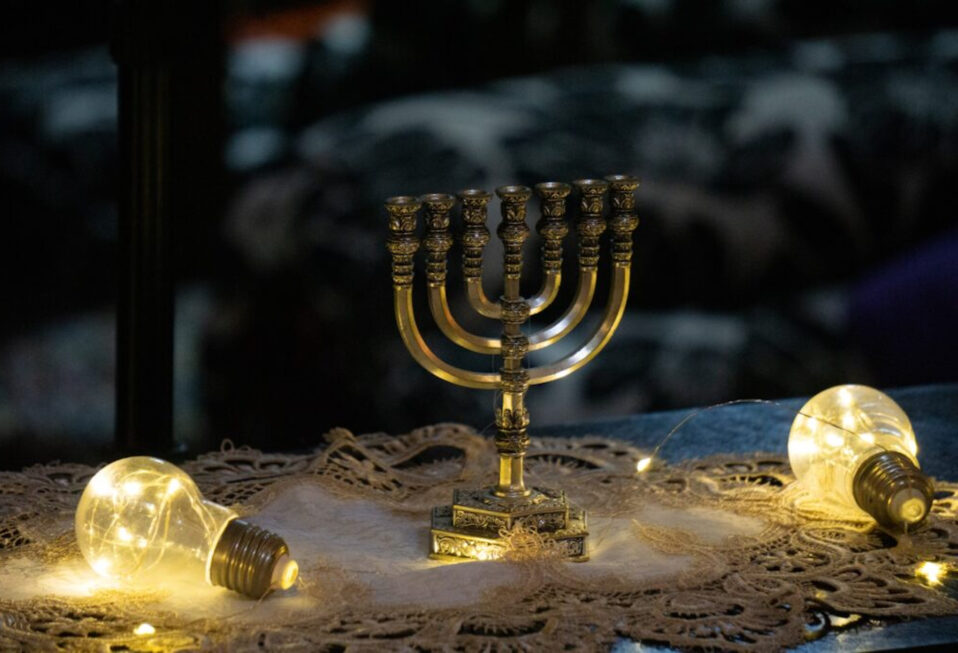The menorah refers to the seven-branched candelabra which God commanded Moses to have fashioned as part of the vessels of the Tabernacles (Exodus 25:31-40; 37:17-24). Artisans fashioned the menorah from a single ingot of gold, with the lamps carved separately from gold. Within the First Temple, the Temple of Solomon, ten golden menorot (plural, menorah) stood in the Temple building, five on the northern wall and five on the southern wall. It is not certain whether these lamps had branches, like the menorah of the Tabernacle. The Babylonians took the menorot from the Temple when they destroyed it and Jerusalem.
The rebuilding of the Temple in Jerusalem required the Judeans to refashion the vessels of the Temple including the menorah. The Jewish writer Jesus ben Sira mentions the golden menorah in the Second Temple in the early second century B.C. The Seleucid king, Antiochus IV, removed it when he converted the Jewish Temple into a Temple to Zeus. Judah the Maccabee made new vessels as part of his purification of the Temple, after he reconquered it from the Seleucid Greeks. It remained in the Second Temple until the Romans destroyed Jerusalem and the Temple. They took the menorah with them to Rome and placed it in the Temple of Peace. Rome’s celebration of the conquest of Judaea appears on the Arch of Titus in Rome where the menorah is shown being conveyed into Rome.
The menorah became a Jewish symbol during the Second Temple period. The last Hasmonean ruler, Mattathias Antigonus, stamped a menorah upon his coins. Archaeologists have discovered menorah graffities in homes and on stones. The menorah stood in the interior of the Temple building, not the Holy of Holies, but the preceding hall. Within the Holy Place, the menorah stood with the incense altar and the table of shewbread. Twice a day priests entered the Temple to tend the lamps of the menorah and offer incense on the altar, at the time of the morning and evening sacrifices. The graffities discovered in Jerusalem depict these three elements together: the menorah, the incense altar, and the table of shewbread.
Archaeologists uncovered a unique stone in a first century synagogue in Magdala, on the shore of the Sea of Galilee. This stone, which archaeologist suggest was a base for a Torah reading stand, bears images from the Jerusalem Temple. The iconography of the stone comes from the Temple. It depicts the menorah and incense altar; some suggest it also shows the table of shewbread, which would be consistent with depictions of the menorah in this period.
After the menorah was taken to Rome, it became a more prominent Jewish symbol appearing in synagogue art throughout the Jewish world. The menorah was the earliest Jewish symbol identifying the presence of Jews. Many today think of the Star of David as a Jewish symbol, but this is modern. Ancient Jews made their mark with the menorah. Some mistakenly refer to the nine-branched candelabra used at Hanukkah as a menorah. It is not. It is a Hanukkiah, the special candelabra for Hanukkah.
Marc Turnage is President/CEO of Biblical Expeditions. He is an authority on ancient Judaism and Christian origins. He has published widely for both academic and popular audiences. His most recent book, Windows into the Bible, was named by Outreach Magazine as one of its top 100 Christian living resources. Marc is a widely sought-after speaker and a gifted teacher. He has been guiding groups to the lands of the Bible—Israel, Jordan, Egypt, Turkey, Greece, and Italy—for over twenty years.
Website: WITBUniversity.com
Facebook: @witbuniversity
Podcast: Windows into the Bible Podcast




Post a comment